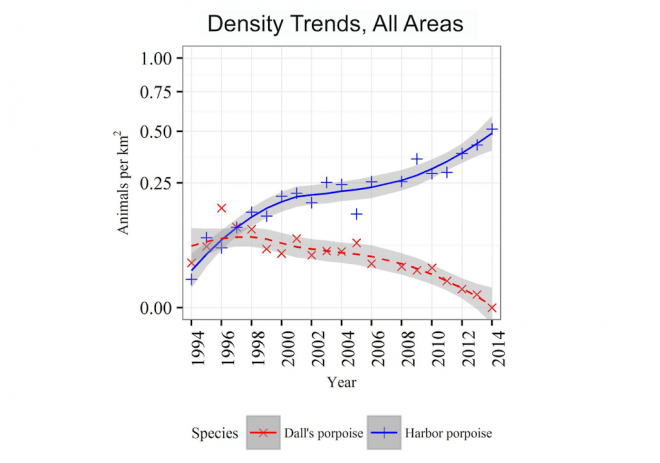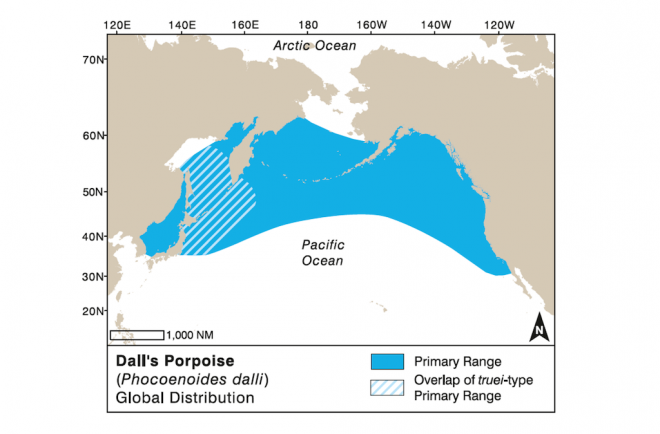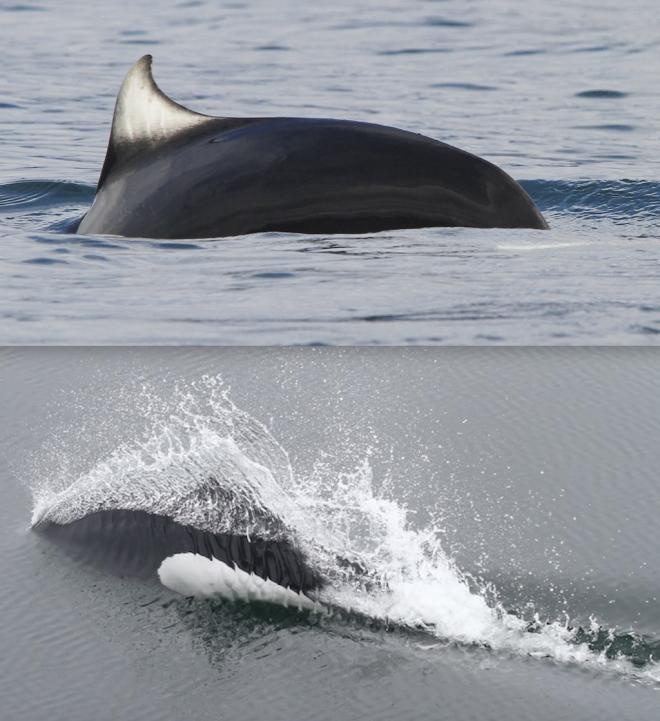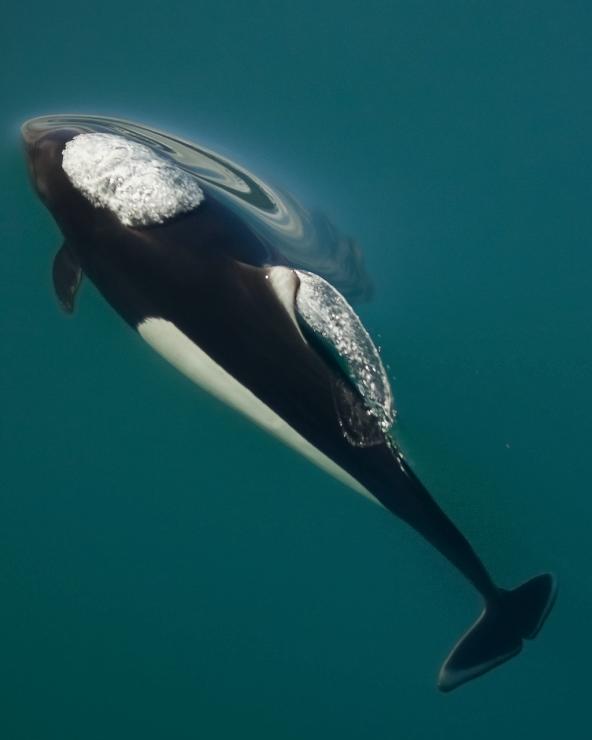The decline of Dall’s porpoise in the Salish Sea
Dall’s porpoises have declined in the Salish Sea since the early 1990s for reasons that are unknown. However, the species, which remains abundant in inshore waters of Alaska and in open coastal and offshore waters of the North Pacific Ocean, is not considered threatened or endangered. Major threats to Dall’s porpoise populations include direct hunting, by-catch in fisheries, and the impacts of environmental contaminants.
Overview
Dall’s porpoises (Phocoenoides dalli) were common in Puget Sound and throughout the Salish Sea until the early 1990s but began to decline toward the end of the last millennium. They have now become rare, coincident with a dramatic recovery of harbor porpoise (Phocoena phocoena) numbers in the Salish Sea. The reason or reasons for the Dall’s porpoise decline are unknown, and it is unclear whether the population crashed or if the animals simply moved elsewhere, but scientists speculate that there may be a connection with the strong increase in harbor porpoise numbers during the same time period (see figure below).
Dall’s porpoise is still abundant in inshore waters of Alaska and in the open coastal and offshore waters of the North Pacific Ocean, and the species is not considered threatened or endangered. The only known conservation issues are in the western Pacific, where they are hunted by the Japanese and are taken in large numbers in some salmon and squid driftnet fisheries.
Status, trends & events

In the early 1990s, using line-transect methods, there were estimated to be as many as 3,015 Dall’s porpoises in the Strait of Juan de Fuca, and 133 in the San Juan Islands area (Calambokidis and Baird 1994; Calambokidis et al. 1997). The species was considered common in all the inshore waters of the Salish Sea, except for shallow and enclosed areas such as southern Puget Sound (south of Seattle) and Hood Canal (Everitt et al. 1979). By the late 1990s, Dall’s porpoise numbers in the Salish Sea were showing evidence of a sustained decline (Ü 2009; Evenson et al. 2016), although there were still estimated to be about 1,500 Dall’s in the Strait of Juan de Fuca, and San Juan/Gulf Islands area in 1996 (Osmeck et al. 1998). By 2013-2015, the species had become very rare in these waters. In 13,908 km of aerial surveys focusing on porpoises, Jefferson et al. (2016) sighted only a single Dall’s in Puget Sound, and in 3,329 km of similar effort in the northern inland waters (around the San Juan Islands and Strait of Juan de Fuca) they only saw four small groups.
Natural history

Dall’s porpoises occur in deep coastal and offshore waters from northern Baja California, Mexico, around the rim of the North Pacific to central Japan, including the Sea of Japan, Bering Sea, and Sea of Okhotsk (Jefferson et al. 2015). There are occasional records from central Baja, which is considered outside the normal range (Jefferson and Braulik 2018).
The distribution is widepread, with significant densities in oceanic waters hundreds or thousands of kilometers from shore. This is a deepwater porpoise, and where they do occur near shore (such as in Puget Sound and the Strait of Juan de Fuca), they are generally found in waters deeper than 100m (and often much deeper). They seem to prefer to feed in areas with strong tidal mixing, which may concentrate prey (see Houck and Jefferson 1999).
Dall’s porpoises feed on a wide variety of prey and are considered opportunistic feeders (Houck and Jefferson 1999). Many species of fish are among their prey, including surface schooling species, such as herring, sardines, and sauries, as well as deepwater fishes such as lanternfish and others associated with the vertically migrating deep scattering layer (Walker et al. 1998). Small to medium size squids are a favorite prey, especially in offshore waters, and it is thought Dall’s are capable of deep dives of hundreds of meters to pursue their prey.
Biology
The overall abundance of Dall’s porpoise is not known with any certainty. Estimates of over 1 million individuals have been made, but there is evidence that these may be overestimated, due to the tendency of the animals to approach vessels to ride the bow wave, therefore biasing estimates. There seems little doubt that the true numbers are in the hundreds of thousands, however (see Jefferson and Braulik, 2018). The US National Marine Fisheries Service (NOAA) recognizes two stocks that occur in US waters. The California/Oregon/Washington stock occurs along the west coast and includes the inland Washington portion. It is estimated to contain at least 16,498 animals (Carretta et al. 2023). The Alaska stock does not have a good estimate of abundance, but there are estimates of several tens of thousands for small portions of the known range (Muto et al. 2022), and the inland waters of southeast Alaska contain about 5,300 porpoises in the peak season (spring) (Jefferson et al. 2019). There are no reliable trends data for either of these stocks, but no pressing conservation issues of concern are known at present.
Dall’s have never been hunted in significant numbers in the eastern North Pacific, but direct hunts in Japan were a very big concern in the 1980s and 1990s. The meat is consumed by people in some Japanese communities. The Japanese government does not regulate these hunts with scientifically valid quotas and it is likely that the local populations were impacted (see Houck and Jefferson 1999). However, those large kills have mostly declined in recent decades. The reasons for this are unclear, but since the quotas were considered unsustainable, one possibility is that it is due to a paucity of animals left to hunt economically.
This is the largest of the seven species of true porpoises, growing to maximum lengths of about 2.4 m, though most animals are much shorter (< 2.2 m). They have a striking black and white color pattern, with a large white patch on the sides, extending across the belly, and white or light gray “frosting” on the dorsal fin and trailing edges of the tail flukes. Newborns are more moderate shades of gray, and do not have the frosting. In some parts of the world, people confuse Dall’s porpoises with “baby killer whales” and their color patterns do indeed bear some resemblance (see Jefferson et al. 2015).
Perhaps one of fastest of all cetacean species, Dall’s are most often observed racing to the bow of vessels traveling at moderate to high speeds, in order to ride the vessel’s bow wave (Houck and Jefferson 1999). There they dart back and forth and surface with a distinctive splash called a roostertail, which obscures much of the animal from view. When not bow riding or otherwise traveling at high speed, Dall’s porpoises surface in a slow roll somewhat similar to that of the more familiar harbor porpoise. From a distance, and in poor lighting the two species can thus be confused, and it may take an expert’s eye to distinguish them. Very little else is known about their behavior, as these animals are a challenge as subjects for long-term behavioral studies.

Mating and breeding probably occur throughout the range, although some inshore areas such as Puget Sound and the waters of northern BC appear to have large concentrations of young calves and may be calving and nursing areas (at least in the past) (see Miller 1989, 1999). Calving is primarily a summer activity, and the gestation period is about 11 months, thereby allowing females to have an annual calving cycle. A single calf is born, at a length of about 95-100 cm, and grows rapidly, being weaned most likely by the end of its first year (Houck and Jefferson 1999).
Narrow-band high-frequency (NBHF) clicks are produced by Dall’s porpoises, which are used in echolocation for navigation and to find food and avoid predators. The main frequency is about 137 kHz, and overlaps with the frequencies used by harbor porpoises (Kyhn et al. 2013). These sounds are largely above the hearing range of the killer whale (Orcinus orca), their main predator. They are not known to produce pure-tone whistles, as many species of dolphins do. Their communication and social system appears to be relatively simple, with only short-term bonds outside the mother/calf pair bond. Dall’s are polygynous, with adult males apparently performing “mate guarding,” escorting an estrus female and monopolizing her during this time, through overt aggression. Much of what we known about this mating system comes from anatomical studies, which indicate that Dall’s are sexually dimorphic, with males longer and heavier, and having secondary sexual characteristics (e.g., enlarged thoracic muscle mass, canted dorsal fins, and post-anal humps of connective tissue).
The overall species is listed as Least Concern on the IUCN Red List, and the International Whaling Commission’s Scientific Committee currently recognizes 11 stocks for management. In US waters, the species is not considered Endangered or Threatened under the US Endangered Species Act (ESA), and neither of the US stocks is considered to be at risk at present (Carretta et al. 2023; Muto et al. 2022).
Major threats to Dall’s porpoise populations include direct hunting, by-catch in fisheries, and the impacts of environmental contaminants. As stated above, the only place where significant hunts for this species occurs is in Japan, and recent catches there no longer appear to be threatening populations. A bigger concern, range-wide is by-catch in various gillnet and trawl fisheries, with the open-ocean driftnet fisheries for western Pacific salmon and squid of most concern. Various chemical pollutants are also considered problematic, and have in some cases been shown to cause damaging health effects and to cause changes that can reduce reproductive capacity (Jefferson and Braulik, 2018).
Almost no directed ecological research has been conducted on Dall’s porpoise in Puget Sound. But, in the late 1980s, Miller (1989, 1990) conducted a multi-year photo-identification study of the species in the area south of Whidbey Island. She was able to identify several dozen individuals and learn something of their habits and movements. Hanson (2007) tagged several Dall’s in Puget Sound and found evidence for movements to outer coastal waters. This suggests that the inland Washington porpoises may not comprise an isolated stock, but may be part of a larger population that moves into and out of inshore waters seasonally, or on longer time scales.
Data sources & gaps
Monitoring and information gaps for this species exist, and in particular estimating abundance for Dall’s porpoise has been fraught with difficulties. Total abundance for the species can only be determined approximately, as potential biases in line transect estimates have not been adequately addressed.
Methods & statistics
The abundance estimates given above have mostly been made through line-transect analysis of shipboard or aerial survey data, and often suffer from potential methodological biases and low levels of precision (Calambokidis and Baird 1994; Calambokidis et al. 1997). The only area for which mark-recapture estimates (in this case from photo-identification) have been made is a very small study area south of Whidbey Island in northern Puget Sound (Miller 1989, 1990).
References
The scientific name of Dall’s porpoise is Phocoenoides dalli. The species was named after William H. Dall, a nineteenth-century American zoologist who collected the type specimen near Adak Island in the Aleutian Islands.
Calambokidis, J. & R. W. Baird. (1994). Status of marine mammals in the Strait of Georgia, Puget Sound and the Juan de Fuca Strait and potential human impacts. In R. C. H. Wilson, R. J. Beamish, F. Aitkens and J. Bell (Eds.), Review of the marine environment and biota of Strait of Georgia, Puget Sound and Juan de Fuca Strait. (pp. 282-303). Canadian Technical Report of Fisheries and Aquatic Sciences.
Calambokidis, J., S. Osmeck & J. L. Laake. (1997). Aerial surveys for marine mammals in Washington and British Columbia inside waters. Unpublished contract report to NMML, NOAA Fisheries, 99 pp.
Carretta, J. V., E. M. Oleson, K. A. Forney, D. W. Weller, A. R. Lang, J. Baker, A. J. Orr, B. Hanson, J. Barlow, J. E. Moore, M. Wallen & R. L. Brownell Jr. (2023). U.S. Pacific marine mammal stock assessments: 2022. NOAA Tech. Memo. NMFS-SWFSC, 684, 404 pp.
Evenson, J. R., D. Anderson, B. L. Murphie, T. A. Cyra & J. Calambokidis. (2016). Disappearance and return of harbor porpoise to Puget Sound: 20 year pattern revealed from winter aerial surveys. Technical Report. Washington Department of Fish and Wildlife and Cascadia Research Collective, Olympia, WA. 26 pp.
Everitt, R. D., C. H. Fiscus & R. L. Delong. (1979). Marine mammals of northern Puget Sound and the Straits of Juan de Fuca. NOAA Technical Memorandum ERL-MESA, 41, 141 pp.
Hanson, M. B. (2007). Seasonal movements and habitat use of Dall's and harbor porpoises in the inland and coastal waters of Washington State as determined by radiotelemetry. NOAA Technical Memorandum NMFS-F/SPO, 82, 53-54.
Houck, W. J. & T. A. Jefferson. (1999). Dall's porpoise Phocoenoides dalli (True, 1885). In S. H. Ridgway and R. Harrison (Eds.), Handbook of Marine Mammals, Volume 6: The Second Book of Dolphins and the Porpoises. (pp. 443-472). Academic Press.
Jefferson, T.A. & Braulik, G. 2018. Phocoenoides dalli. The IUCN Red List of Threatened Species 2018: e.T17032A50370912. https://dx.doi.org/10.2305/IUCN.UK.2018-2.RLTS.T17032A50370912.en. Accessed on 11 March 2024.
Jefferson, T. A., M. A. Webber & R. L. Pitman. (2015). Marine Mammals of the World: A Comprehensive Guide to Their Identification. Academic Press/Elsevier.
Jefferson, T. A., M. A. Smultea, S. S. Courbis & G. S. Campbell. (2016). Harbor porpoise (Phocoena phocoena) recovery in the inland waters of Washington: Estimates of density and abundance from aerial surveys, 2013-2015. Canadian Journal of Zoology, 94, 505-515.
Jefferson, T. A., M. E. Dahlheim, A. N. Zerbini, J. M. Waite & A. S. Kennedy. (2019). Abundance and seasonality of Dall’s porpoise (Phocoenoides dalli) in Southeast Alaska. NOAA Technical Memorandum NMFS-AFSC, 385, 45 pp.
Kyhn, L. A., J. Tougaard, K. Beedholm, F. H. Jensen, E. Ashe, R. Williams & P. T. Madsen. (2013). Clicking in a killer whale habitat: Narrow-band, high-frequency biosonar clicks of harbour porpoise (Phocoena phocoena) and Dall’s porpoise (Phocoenoides dalli). Plos One, 8, e63763.
Miller, E. J. (1989). Distribution and behavior of Dall's porpoise (Phocoenoides dalli) in Puget Sound, Washington. M.Sc. thesis, University of Washington, 97 pp.
Miller, E. J. (1990). Photo-identification techniques applied to Dall's porpoise (Phocoenoides dalli) in Puget Sound, Washington. Reports of the International Whaling Commission, Special Issue 12, 429-437.
Muto, M. M. and B. J. D. V. T. Helker, N. C. Young, J. C. Freed, R. P. Angliss, N. A. Friday, P. L. Boveng, J. M. Breiwick, B. M. Brost, M. F. Cameron, P. J. Clapham, J. L. Crance, S. P. Dahle, M. E. Dahlheim, B. S. Fadely, M. C. Ferguson, L. W. Fritz, K. T. Goetz, R. C. Hobbs,Y. V. Ivashchenko, A. S. Kennedy, J. M. London, S. A. Mizroch, R. R. Ream, E. L. Richmond,K. E. W. Shelden, K. L. Sweeney, R. G. Towell, P. R. Wade, J. M. Waite, & A. N. Zerbini. (2022). Alaska marine mammal stock assessments, 2021. NOAA Technical Memorandum, NMFS-AFSC-441, 295 pp.
Osmek, S., J. Calamabokidis & J. L. Laake. (1998). Abundance and distribution of porpoise and other marine mammals of the inside waters of Washington and British Columbia. In: Proceedings of the 4th Puget Sound Research Conference. p.868-880. Held on March 12-13 1998. Seattle, WA.
Ü, A. (2009). Summertime density, abundance, and distribution of harbor porpoise and Dall's porpoise in the inside waters of Washington. M.R. thesis, University of Aberdeen, 79 pp.
Walker, W. A., M. B. Hanson, R. W. Baird & T. J. Guenther. (1998). Food habits of the harbor porpoise, Phocoena phocoena, and Dall's porpoise, Phocoenoides dalli, in the inland waters of British Columbia and Washington. AFSC Processed Report, 98-10, 63-75.
Acknowledgments
The author thanks Joe Gaydos for comments on an earlier draft, the University of Washington Puget Sound Institute for funding and also the Puget Sound Ecosystem Monitoring Program's Marine Mammals Working Group for helping to facilitate the production of this chapter.
Licensing & attribution
Data and products from the PSEMP Marine Mammal Work Group are governed by a Creative Commons BY-NC-SA license. Attribution should be to: “PSEMP Marine Mammal Work Group” with a link back to https://psemp.net/mmwg.






